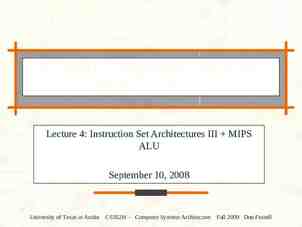Lifting Hazards and some ideas on how to reduce your risk of
48 Slides3.15 MB
Lifting Hazards and some ideas on how to reduce your risk of lifting injury
By the end of this slideshow you will be able to: Identify the 3 types of lifting that may cause injuries Review ergonomics principles used in reducing lifting hazards and preventing injuries Contact L&I resources for assistance
Statistics on Lifting Injuries There are 50,000 sprains and strains in Washington every year. How many of them are due to lifting? 17,000! (34%) This means that about 1/3 of sprains and strains are attributed to lifting. That makes it one of the largest single sources of injury in Washington workplaces.
Lifting Injuries Aren’t Just Back Injuries Lifting results in: 30% of Shoulder sprains and strains 43% of Back sprains and strains 22% of Elbow sprains and strains 13% of Hand/Wrist sprains and strains
Lifting Injuries Aren’t Just Due to Aging “Overexertion in lifting a heavy object is the most frequent single type of injury for those under 18 resulting in lost work-time.” Source: American Society of Safety Engineers (ASSE, 2003)
Pay special attention to Heavy lifting Frequent lifting Awkward lifting
Heavy Lifting Moving bags of dry ingredients from a pallet to a hopper. The bags weigh anywhere from 50 to 80 pounds.
Frequent Lifting Taking totes of small parts off a conveyor and stacking them on pallets He lifts 5 to 6 totes per minute for most of the day
Awkward Lifting Lifting 50-pound bags of wet fiberglass out of a deep shipping tote Lifts that are: Above the shoulders Below the knees At arms’ length
Analysis tools L&I/Oregon OSHA Lifting Calculator Other tools: – ACGIH Lifting TLV – NIOSH Lifting Equation Links to these tools are in the appendix at the end of this slide show
Principles for reducing heavy lifting Reduce the weight Increase the weight Use mechanical assistance Slide instead of lift Team lifting
Reducing heavy lifting Reduce the weight of the load Wood pallet 60 pounds Plastic pallet 20 pounds
Reducing heavy lifting Increase the weight of the load And use machines to move it
Reducing heavy lifting Use mechanical assistance Pneumatic conveyor
Reducing heavy lifting Slide instead of lift
Reducing heavy lifting Team lifting
Principles for reducing frequent lifting Use mechanical assistance Avoid unnecessary lifting Use mobile storage
Reducing frequent lifting Instead of lifting by hand use mechanical assistance
Reducing frequent lifting Use mobile storage: Parts stay on racks as they move from one manufacturing process to the next
Principles for reducing duration of lifting Rotate to other jobs Use mechanical assistance
Reducing duration of lifting Rotate to nonlifting tasks
Principles for reducing awkward lifting - reaching Remove obstacles Slide closer Reduce shelf depth Reduce package size Use mechanical assistance Team lifting
Reducing awkward lifting - reaching Remove obstacles Cut-out in side of tote allows easier access
Reducing awkward lifting - reaching Slide objects closer “Homemade” hook for pulling small boxes to edge of shelf
Reducing awkward lifting - reaching Reduce shelf depth Flow racks bring boxes to the front of shelves
Reducing awkward lifting - reaching Reduce package size
Reducing awkward lifting - reaching Use mechanical assistance Electric hoist can lift two bags at a time
Reducing awkward lifting - reaching - Team lifting
Principles for reducing awkward lifting - bending Use mechanical assistance to raise the load Add handles Arrange storage Avoid unnecessary lifting
Reducing awkward lifting - bending Use mechanical assistance to raise the load Scissor-lift cart
Reducing awkward lifting - bending Add handles
Reducing awkward lifting - bending Rearrange storage Heavy items at waist level
Reducing awkward lifting - bending Avoid unnecessary lifting Tire hanger keeps wheels up off the floor in auto shop
Principles for reducing awkward lifting – reaching above shoulders Arrange storage Use mechanical assistance Use a rolling stair or “safety ladder”
Reducing awkward lifting – reaching above shoulders Arrange storage
Reducing awkward lifting – reaching above shoulders Use mechanical assistance “Stacker” lift device has hand winch to raise and lower platform
Reducing awkward lifting – reaching above shoulders Use mechanical assistance Combining 2 half-height stacks instead of lifting overhead
Reducing awkward lifting – reaching above shoulders - Use a rolling stair
Principles for reducing awkward lifting - twisting Use conveyors Provide more space Arrange storage
Reducing awkward lifting - twisting - Use conveyors Allows boxes to be unloaded and checked in with minimal lifting
Reducing awkward lifting - twisting Re-arrange storage More space means less bending and twisting
How to find ideas Resources: – Your employees – Your suppliers – Your industry association – Industry-specific equipment catalogs – Product vendors – Internet searches
Ergonomics Ideas Bank Lni.wa.gov\ErgoIdeas
Lifting techniques training Teaching lifting techniques to employees: – Giving training alone is not effective – Making changes to jobs and equipment is better – Making changes along with training is most effective
Lifting techniques training Job-specific, on-site, handson training is more effective than classroom Have employees demonstrate proper lifting techniques before “graduating”
Appendix - Links Lifting Calculators L&I / Oregon OSHA Lifting Calculator NIOSH Lifting Equation calculator NIOSH Lifting Equation app NIOSH Lifting Equation user manual
Help from L&I at no cost to you We offer free, confidential consultations to help you prevent sprains and strains in your workplace. To learn more: Email – [email protected] Call – (360) 902-5450 Click – Ergonomics Consultation Brochure
You’re done! Thank you for your time and attention





















































